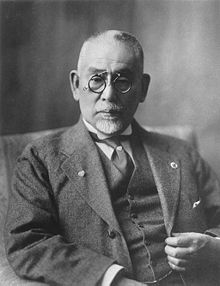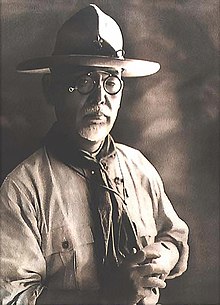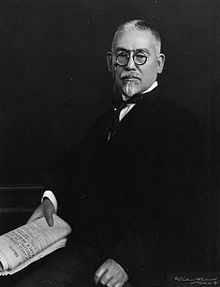Gotō Shinpei
Gotō Shinpei | |
|---|---|
 | |
| Born | 24 July 1857 Isawa District, Iwate, Japan |
| Died | 13 April 1929 (aged 71) Okayama, Japan |
| Cause of death | cerebral hemorrhage |
| Resting place | Aoyama Cemetery, Tokyo, Japan |
| Nationality | Japanese |
| Occupation(s) | Politician, Cabinet Minister |

Count Gotō Shinpei (後藤 新平, 24 July 1857 – 13 April 1929) was a statesman and cabinet minister in the Taishō and early Shōwa period Empire of Japan. He served as the head of civilian affairs of Taiwan under Japanese rule, the first director of the South Manchuria Railway, the seventh mayor of Tokyo City, the first Chief Scout of Japan, the first director of NHK, the third principal of Takushoku University, and in a number of cabinet posts.
Early life
Gotō was born in Isawa, Mutsu Province (present-day in Iwate Prefecture). He entered Sukagawa medical school in Fukushima Prefecture at the age of seventeen, and became a doctor in Nagoya after graduation. In 1877, he served as a government medic during the Satsuma Rebellion. At the age of 25, he became president of the Nagoya Medical School.[1]
Having distinguished himself through his work at the Nagoya Medical School and at the military hospital in Osaka during the Satsuma Rebellion, Gotō joined the Home Ministry's medical bureau (衛生局) in 1883, eventually becoming its head. In 1890 Gotō was sent by the Japanese government to Germany for further studies.[1] While at the ministry, in 1890 he published his Principles of National Health (国家衛生原理) and took part in the creation of new sewage and water facilities in Tokyo. This recommended him to Army Vice-Minister Kodama Gentarō (1852–1906), who made Gotō chief of the Army Quarantine Office looking after the return of more than 230,000 soldiers from the First Sino-Japanese War (1895–95). After the war, Gotō returned to the Home Ministry, but remained involved in overseas affairs, advising the new Japanese administration on Taiwan about health issues. In 1896, Kodama, now governor-general of Taiwan, asked Gotō to join him there, eventually making him the first civilian governor of the island in 1898.[2]
Taiwan
At the end of the war, Qing China ceded Formosa and the Pescadores (see modern-day Taiwan) to Japan via the Treaty of Shimonoseki. Kodama became the Governor-General of Taiwan, and Gotō was asked to become the head of civilian affairs in his government.[3]
Gotō ordered a land survey and recruited Scottish engineer William Kinninmond Burton to develop an infrastructure for drinking water and sewage disposal. Gotō replaced the military police by a civilian police force, forbid government officials and teachers from wearing uniforms and swords, and revived traditional forms of social control by enlisting village elders and headmen into the administration.[3] Gotō also built a public hospital and medical college in Taipei, and clinics to treat tropical diseases around the island. Opium addiction was an endemic problem in China at the time, and Taiwan was no exception. Gotō recommended a policy of the gradual prohibition of opium. Under this scheme, opium could only be purchased from licensed retailers. As a result of the strict enforcement, the number of addicts dropped from 165,000 in 1900 to less than 8,000 by 1941,[4] none of whom was younger than 30. In addition, as government revenues from opium sales was lucrative and Gotō used opium sales licenses to reward Taiwanese elite loyal to the Japanese Empire and those who assisted in the suppression of the Taiwan Yiminjun (Chinese: 台灣義民軍), an armed group that resisted Japanese rule. The plan achieved both its purposes: opium addiction dropped gradually and the activities of the Yiminjun were undermined.
As a doctor by training, Gotō believed that Taiwan must be ruled by "biological principles" (生物学の原則), i.e. that he must first understand the habits of the Taiwanese population, as well as the reasons for their existence, before creating corresponding policies. For this purpose, he created and headed the Provisional Council for the Investigation of Old Habits of Taiwan.
Gotō also established the economic framework for the colony by government monopolization of sugar, salt, tobacco and camphor and also for the development of ports and railways. He recruited Nitobe Inazō to develop long-range plans for forestry and sub-tropical agriculture. By the time Gotō left office, he had tripled the road system, established a post office network, telephone and telegraph services, a hydroelectric power plant, newspapers, and the Bank of Taiwan. The colony was economically self-supporting and by 1905 no longer required the support of the home government despite the numerous large-scale infrastructure projects being undertaken.[5]

Statesman
In 1906, Gotō became the first director of the South Manchuria Railway Company. In 1908, he returned to Japan as Minister of Communications and the head of the Railway Bureau (Tetsudōin), under the second Katsura administration. In 1912, Gotō became director of the Colonization Bureau (拓殖局総裁, Takushokukyoku). A close confidant of Prime Minister Katsura, he assisted in the formation of the Rikken Dōshikai political party after the Taisho Political Crisis in 1912. Following Katsura’s death, he allied with Yamagata Aritomo and became Home Minister in 1916, and Foreign Minister in the Terauchi administration in 1918.[6]
A strong believer in Pan-Asianism, Gotō pushed for an aggressive and expansionist Japanese foreign policy during World War I, and strongly endorsed the Japanese intervention in Siberia.[6]
Gotō served as Mayor of Tokyo City in 1920, and again as Home Minister in 1923, contributing to the reconstruction of Tokyo following the 1923 Great Kantō earthquake.[6]
In 1924, Citizen Watch Co.'s forerunner, the Shokosha Watch Research Watch Institute, produced its first pocket watch, and presented it to mayor Gotō. Gotō named the watch "citizen" with the hope that the watch, then a luxury item, would one day become widely available to ordinary citizens.[citation needed]
Gotō died of a cerebral hemorrhage in 1929 while on a visit to Okayama.[7] His papers are preserved at the Gotō Shinpei Memorial Museum, which is situated in his birthplace, Mizusawa City, in Iwate Prefecture.
Scouting
Gotō was made the first Chief Scout of Japan and tasked with reforming the newly federated organization in the early 1920s. As Minister of Railways, Count Gotō traveled around the country, and was able to promote Scouting all over Japan in his spare time. In 1956 he posthumously received the highest distinction of the Scout Association of Japan, the Golden Pheasant Award.[8]
Inaugural order
References
- ^ a b Frédéric (2002), p. 264.
- ^ Sewell, Bill (2004). "Reconsidering the Modern in Japanese History: Modernity in the Service of the Prewar Japanese Empire". Japan Railway & Transport Review. 16. Japan Review: 213–258.
{{cite journal}}:|access-date=requires|url=(help); Cite has empty unknown parameter:|coauthors=(help) - ^ a b Tsai (2005), pp. 12–4.
- ^ Jennings (1997), p. 21–5.
- ^ Rubinstein (2007), p. 209–11.
- ^ a b c Tucker (2002), p. 798–9.
- ^ Perez (2002), p. 99.
- ^ reinanzaka-sc.o.oo7.jp/kiroku/documents/20140523-3-kiji-list.pdf
Bibliography
- Jennings, John (1997). The Opium Empire: Japanese Imperialism and Drug Trafficking in Asia, 1895-1945. Greenwood Publishing. ISBN 0275957594.
{{cite book}}: Invalid|ref=harv(help) - Frédéric, Louis (2002). Japan Encyclopedia. Harvard University Press. ISBN 0674017536.
{{cite book}}: Invalid|ref=harv(help) - Perez, Louis G (2002). Japan at War: An Encyclopedia. ABC CLIO. ISBN 1851098798.
{{cite book}}: Invalid|ref=harv(help) - Rubinstein, Murray A (2007). Taiwan: A New History. M E Sharpe. ISBN 0765614944.
{{cite book}}: Invalid|ref=harv(help) - Tsai, Henry (2005). Lee Teng-Hui and Taiwan's Quest for Identity. Palgrave Macmillan. ISBN 1403977178.
{{cite book}}: Invalid|ref=harv(help) - Tucker, Spencer (2002). World War I: A Student Encyclopedia. ABC CLIO. ISBN 1851098798.
{{cite book}}: Invalid|ref=harv(help)
External links
 Media related to Gotō Shinpei at Wikimedia Commons
Media related to Gotō Shinpei at Wikimedia Commons- Goto Shimpei no Kai
- Goto, Shinpei | Portraits of Modern Japanese Historical Figures (National Diet Library)
- Use dmy dates from July 2013
- 1857 births
- 1929 deaths
- Japanese physicians
- Government ministers of Japan
- Foreign ministers of Japan
- Ministers of Home Affairs of Japan
- Scouting in Japan
- Kazoku
- Taiwan under Japanese rule
- Mayors of Tokyo
- Scouting pioneers
- Politicians from Iwate Prefecture
- People of Meiji-period Japan
- Rikken Dōshikai politicians
- 20th-century Japanese politicians
- Japanese people in rail transport
- Citizen Watch
- Pan-Asianists
